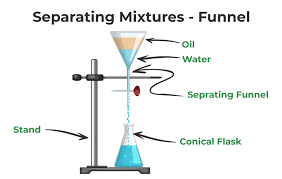
In the realm of chemistry, numerous techniques are employed to separate mixtures of soluble substances. These techniques are fundamental to various industries, including pharmaceuticals, environmental sciences, and food processing. Understanding these techniques is crucial for chemists and scientists to analyze and extract valuable components from complex mixtures.
In this article, we delve into the technique used to separate a mixture of soluble substances, its applications, and the underlying principles that govern its effectiveness. So, without further ado, let's explore this fascinating method and uncover its secrets.
What is the Technique Used to Separate a Mixture of Soluble Substances?
The technique used to separate a mixture of soluble substances is known as fractional crystallization. This method exploits the differences in solubilities of individual components in a mixture to achieve separation. By carefully controlling the temperature and rate of crystallization, chemists can isolate desired substances with high purity.
The Principles Behind Fractional Crystallization
Fractional crystallization operates on the principle that different substances have varying solubilities at different temperatures. By gradually cooling a solution, the solubility of the least soluble component decreases, causing it to crystallize out first. This selective crystallization allows chemists to separate components based on their solubility properties.
To better understand fractional crystallization, let's explore the process in more detail.
The Process of Fractional Crystallization
Step 1: Dissolving the Mixture
The first step in fractional crystallization involves dissolving the mixture of soluble substances in a suitable solvent. The choice of solvent depends on the specific substances being separated and their solubility characteristics. The solvent should have high solubility for the desired compound and low solubility for the impurities.
Step 2: Heating and Stirring
Once the mixture is dissolved, the solution is heated and stirred to ensure uniform distribution of the components. Heating increases the solubility of all substances, allowing them to dissolve completely in the solvent.
Step 3: Cooling the Solution
After complete dissolution, the solution is gradually cooled at a controlled rate. This cooling process is crucial for the separation of components based on their solubilities. As the temperature decreases, the solubility of the least soluble component decreases, leading to the formation of crystals.
Step 4: Crystallization and Separation
As the crystals form, they are separated from the remaining solution using various methods such as filtration or decantation. The separated crystals can then be further purified through additional recrystallization steps to obtain a highly pure compound.
Applications of Fractional Crystallization
Fractional crystallization finds extensive applications in various fields. Let's take a closer look at some of its notable applications:
Pharmaceutical Industry
In the pharmaceutical industry, fractional crystallization is utilized to extract and purify active pharmaceutical ingredients (APIs) from complex mixtures. This technique enables the production of high-quality drugs with precise concentrations and minimal impurities, ensuring their safety and efficacy.
Chemical Synthesis
Fractional crystallization plays a vital role in chemical synthesis processes, where it is employed to separate reaction products from unreacted starting materials and by-products. By isolating desired compounds, chemists can achieve higher yields and improve the overall efficiency of their synthetic routes.
Environmental Analysis
Environmental scientists utilize fractional crystallization to analyze water and soil samples for pollutants and contaminants. By isolating specific substances through crystallization, researchers can accurately measure their concentrations and assess the environmental impact.
Frequently Asked Questions
What are the advantages of fractional crystallization over other separation techniques?
Fractional crystallization offers several advantages over alternative separation techniques. Firstly, it allows for the isolation of compounds with high purity levels, ensuring accurate analysis and reliable results. Additionally, fractional crystallization is a cost-effective method and can be easily scaled up for large-scale purification processes.
Can fractional crystallization be used to separate mixtures of insoluble substances?
No, fractional crystallization is specifically designed for the separation of soluble substances. It exploits differences in solubility to achieve the desired separation. For mixtures of insoluble substances, other techniques such as filtration or centrifugation are more suitable.
Are there any limitations to fractional crystallization?
While fractional crystallization is a versatile and effective technique, it does have some limitations. The success of fractional crystallization relies on the presence of significant differences in solubility between the components. If the solubility differences are minimal, the separation may be challenging or impractical.
Conclusion
The technique used to separate a mixture of soluble substances, known as fractional crystallization, plays a vital role in various scientific and industrial endeavors. By harnessing the differences in solubilities, chemists can achieve precise separation and purification of complex mixtures. This technique finds applications in pharmaceuticals, chemical synthesis, and environmental analysis, among other fields.
Next time you encounter a complex mixture, remember the power of fractional crystallization and the remarkable ability it offers to chemists and scientists to unlock the secrets hidden within.
